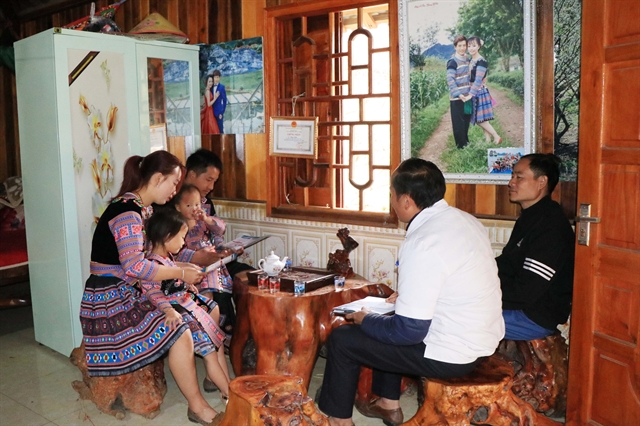 |
| A nurse in the Neonatal Department at Hùng Vương Hospital in HCM City caring for a new born. VNA/VNS Photo Đinh Hằng. |
HÀ NỘI – Looking back on 30 years since Việt Nam adopted the action programme at the International Conference on Population and Development the country has achieved significant accomplishments in population work.
However, Việt Nam needs innovations to address existing challenges to sustain economic and social development.
This was delivered by health experts on the World Population Day 2024 (July 11) under the theme ‘Investing in Population Work is Investing in Sustainable Development’.
In 1994 in Cairo, Việt Nam, along with 178 countries worldwide, signed the far-reaching action programme that placed people at the centre of development at the ICPD. This programme emphasised the close relationship between population and sustainable development, promoting an integrated approach in economic, social and population policies.
Việt Nam’s progress
Over the past 30 years, Việt Nam has implemented many innovative methods to address inequality and narrow the socio-economic development gap between regions and population groups.
Resolution 21-NQ/TW on Population Work in the new situation clearly outlined the 12th Party Central Committee’s guiding principle, which considers population work and development both an urgent and long-term strategic task.
Việt Nam’s achievements in the field of population and development have been recognised over the years. Since 2006, the population growth rate has been successfully controlled, maintaining replacement fertility levels. The population structure has shifted positively, with the labour force of the working age increasing significantly.
According to the Ministry of Health, in 2023, Việt Nam’s population surpassed 100 million, making it the 15th country in the world with a population of over 100 million people. The number and proportion of the population of working age account for nearly 70 per cent, during the golden population structure period.
The quality of the population has comprehensively improved, with the average life expectancy rising rapidly, surpassing many countries with similar average income levels. According to the results of Việt Nam’s population censuses since 1989, the average life expectancy of Vietnamese people has continuously increased, from 65.2 to 73.7 at the end of 2023. In terms of life expectancy, the country ranks fourth in Southeast Asia (with 66 being the lowest in the region) and exceeds the global average of 73.4 years.
The stature and physical fitness of Vietnamese people have also significantly improved. According to the results of the National Nutrition Survey 2017-2020, the average height of 18-year-old male in 2020 reached 168.1 cm, an increase of 3.7 cm compared to 2010, and for females, it reached 156.2 cm in 2020 compared to 154.8 cm in 2010.
Việt Nam has surpassed global trends in reducing maternal mortality rates and achieving high rates of modern contraceptive use. According to the Ministry of Health, the under-five mortality rate in Việt Nam in 2023 was 18.9 per thousand, with an average annual decrease of 0.22 per thousand over the past five years.
The poverty reduction policies and programmes of the Party and State have been well-implemented, gradually improving and enhancing the living conditions of poor households. The central budget allocated for implementing poverty reduction policies in 2023 exceeded VNĐ20 trillion.
Proper policies
Phạm Vũ Hoàng, Deputy Director of the Ministry of Health’s General Office of Population and Family Planning, stated that the Party and State have always adjusted policies to suit the reality in Việt Nam, in light of international and domestic population demands.
On October 25, 2017, the 12th Central Party Committee’s six plenary session issued Resolution No 21-NQ/TW on population work. Its aim – by 2030, 90 per cent of young men and women will receive pre-marital counselling and health check-ups. The number of child marriages will be reduced by 50 per cent and consanguineous marriages by 60 per cent. 70 per cent of pregnant women will be screened for at least four of the most common congenital diseases. 90 per cent of newborns will be screened for at least five of the most common congenital diseases.
The average life expectancy of Vietnamese people will reach 75 years. All elderly people will have health insurance, manage their health, receive medical examinations and treatment.
By 2030, the height of 18-year-old males will reach 168.5 cm and females 157.5 cm. The Human Development Index (HDI) will be among the top four in Southeast Asia.
To implement the resolution, on September 2, 2018, the Prime Minister approved the Việt Nam Health Programme to improve the well-being, stature, lifespan and life quality of Vietnamese people.
From 2018 to 2030, the programme focuses on 11 areas divided into three groups, including health promotion, health protection and disease prevention, primary health care and disease control.
 |
| A population officer raises awareness among the residents of Vân Hồ District in Sơn La Province about gender imbalance at birth. VNA/VNS Photo Hữu Quyết |
To enhance maternal and child health care and reduce under-five mortality rates, on June 26, the Ministry of Health issued Directive 05/CT, calling for increasing budget allocations for interventions to reduce child mortality, improving emergency and neonatal resuscitation capabilities and essential care for mothers and newborns.
In July, the Government issued Decree 76/2024/NĐ-CP, raising the social allowance for the elderly, with the highest level reaching VNĐ1.5 million.
The Party and State have implemented many specific policies to improve the living standards of ethnic minority communities. The Committee for Ethnic Minority Affairs reported that there are currently 188 policies in place for ethnic minorities and mountainous regions. In 2023, the percentage of poor households among ethnic minorities decreased to approximately 17.82 per cent, a reduction of 3.2 per cent compared to 2022.
Continuing challenges
However, Việt Nam still faces several significant challenges, such as disparities in birth rates across regions, rapid population aging and gender imbalance at birth.
The considerable differences in fertility rates between regions and groups, along with the risk of not achieving the goal of maintaining replacement fertility nationwide, pose significant challenges. The rapid aging of the population and the prospect of becoming an aging society early present major difficulties for economic development and social welfare.
The sex ratio at birth remains high while early marriage and consanguineous marriages are slow to be addressed. The quality of the population, especially in remote, isolated and disadvantaged areas, remains limited.
In anticipation of World Population Day on July 11 this year, the Ministry of Health has urged local health authorities to focus on activities aimed at raising awareness and promoting reproductive health. Awareness campaigns emphasise the benefits of having two children, gender equality and reproductive autonomy.
Additionally, premarital health check-ups and counselling for young people should be conducted regularly to ensure healthy pregnancies and prevent genetic diseases. Legal compliance against early marriage and consanguineous marriages should be focused on protecting genetic diversity.
Nationwide public communication also seeks to enhance the role and status of women and girls within families, communities and society, it said.
According to the ministry, moving forward, Việt Nam must continue to improve population quality, reduce regional disparities and ensure balanced and sustainable development for future generations. – VNS
- Reduce Hair Loss with PURA D’OR Gold Label Shampoo
- Castor Oil Has Made a “Huge” Difference With Hair and Brow Growth
- Excessive hair loss in men: Signs of illness that cannot be subjective
- Dịch Vụ SEO Website ở Los Angeles, CA: đưa trang web doanh nghiệp bạn lên top Google
- Nails Salon Sierra Madre
 VnExpress News The News Gateway of Vietnam
VnExpress News The News Gateway of Vietnam





